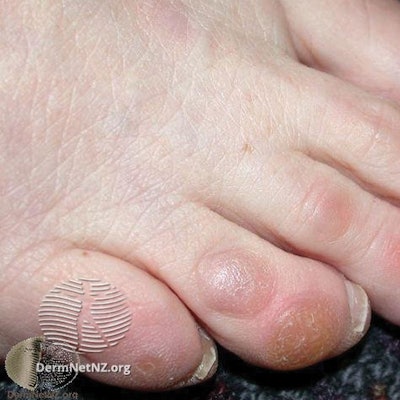
Putting on a pair of heels for a holiday party may be the last thing your client wants to do if she’s suffering from painful and unsightly corns—areas of thickened skin that commonly develop on the feet and toes to protect the skin from irritation. As a nail tech, however, you can help clients with corns find some relief and improve their feet’s appearance. Here, learn how to safely and effectively care for corns during pedicure services.
Understanding Corns
The first thing nail techs should know about corns—one of the most common foot ailments— is that they aren’t contagious. According to the American Podiatric Medical Association (APMA), corns occur when something rubs against the foot repeatedly or causes excess pressure against part of the foot. Corns are most often caused by tight- or ill-fitting shoes, not wearing socks, foot deformities, such a bunions and hammertoes, frequent walking or running and aging. If corns aren’t treated in a timely manner, the root of the corn can reach the nerve ending and compress it, causing pain, says Florida-based North American School of Podiatry certified master pedicurist Anna Byrnes. “Deep core calluses can form as a result, and frequent and long-term healing corns can be a manifestation of serious problems,” says Byrnes.
Although people sometimes mistakenly use the terms corns and calluses interchangeably, they aren’t the same. Corns and calluses do, however, fall into the same skin condition category, known as hyperkeratosis, where the skin thickens due to the body producing extra keratin, a fibrous protein found in the fingernails, hair and skin. This keratin can thicken and cause corns and calluses because of inflammation, pressure or a genetic condition. According to the APMA, the term callus is commonly used if the thickening of the skin is located on the bottom of the foot, while the term corn refers to thickening occurring on the top of the foot or toe. But location isn’t as important as the thickened skin’s pattern and appearance. Flat, widespread skin thickening, sometimes appearing yellowish in color, indicates a callus, and skin lesions that are smaller, thicker and deeper indicate a corn. Hard corns are sometimes pink due to inflammation and located on top of bony toes, while soft corns have a rubbery texture with a whitish color and are located in between toes. A final distinction: Corns can be painful when pressed on, but calluses are usually not painful.
RELATED: Test Yourself November 2018 – It’s the Joint
Servicing Clients With Corns
While corns can go away on their own, nail technicians can also help alleviate clients’ discomfort by treating the condition during services. “The use of pumice stones of varying roughness is recommended on clean, moist surfaces,” says Byrnes. Jolivette Wallace, Ph.D., owner of Mani’s & Pedi’s in Ridgeland, Mississippi, says she frequently sees corns on clients at her salon, many of whom are professional women who often wear high heels. For clients who have corns, Wallace always begins each pedicure service with an 8-to-10 minute soak in warm water to soften the thickened skin. “This is a very important step,” says Wallace. “Next, we safely file the corn with a warm, wet pumice stone. Carefully moving the stone in a circular motion aids in the removal of the dry skin. It’s important to be gentle and steer away from rough or abrasive filing.” The service concludes with a moisturizing mask and lotion. Post- service, Wallace encourages at-home care using a moisturizing lotion or cream that contains salicylic acid, ammonium lactate or urea. “These ingredients help gradually soften hard corns and calluses,” she explains.
Although some clients expect immediate results, nail technicians should never perform risky services, warns Wallace. “Unfortunately in the nailcare industry, some technicians perform unsafe and even illegal practices for the convenience of a smooth appearance,” she says. “This is dangerous, unsanitary and can be detrimental to the client’s health. Clients have requested the credo blade or ‘cheese grater,’ although this is illegal in the state of Mississippi. Our goal and concern are for the care of our clients. We’re patient in educating our clients on nail health and procedures that will benefit them in the long term.”
While it’s generally safe to service clients with corns, nail techs should recommend that they see a podiatrist if their corns become very painful or inflamed or inhibit their daily life. Also, people with diabetes, poor circulation or other serious illnesses should have their feet checked regularly.
RELATED: 5 Ways to Stay Sane During the Holidays and Prepare for the New Year
Prevention
During services, techs can take the opportunity to offer clients who have corns helpful tips for homecare. “Look for shoes that fit well and are comfortable, wear padding around the corn to prevent the corn from coming in contact with the shoe and keep toenails professionally trimmed,”saysWallace. In addition, wearing clean, breathable cotton socks can help: When feet are sweaty, they can cause the foot to move around and create harsh friction on the skin. Though corns may be a nuisance for clients, nail techs can help by providing gentle care and some common-sense tips for prevention.
Corn Facts
- Corns are thick, hardened layers of skin that develop when the skin tries to protect itself against friction and pressure.
- Bunions, hammertoes and other foot deformities increase the risk of corns.
- Corns are smaller than calluses and have a hard center surrounded by inflamed skin.
- Women are more likely to develop corns than men.
- Two-thirds of corns occur on the top of the toe because of its deformation from ill-fitting shoes.
Sources: Mayo Clinic, mayoclinic.org; Anna Byrnes, certified master pedicurist
–by Megan James
[Image: Courtesy of dermnetnz.org]











